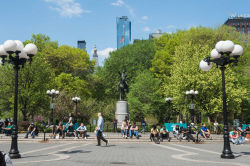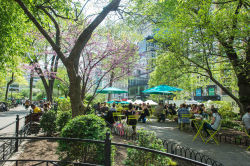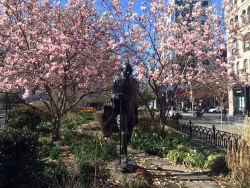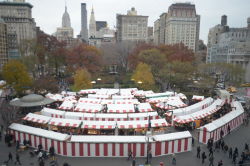Union Square Park
The Daily Plant : Tuesday, February 3, 2015
Spit And Polish, Sweat And Tears: The Human Story Behind Parks Historic Image Of Union Square Shoeshine Stand

Fifteen years ago while preparing an Arsenal Gallery exhibition on parks concessions, I came across the image above of a solitary bootblack, taken February 28, 1934 in Union Square Park. The stark beauty of this image stunned me in its simplicity and poignancy, and I featured it in the show, Making Concessions: A Pictorial History of Commercial Enterprises in New York City Parks.
The picture had been taken to document the newly-issued shoeshine equipment, and not the individual, whose identity was then unknown, but who lent a slice of humanity to the image. Touched by the expressive composition here's how I captioned the photo: "A shoeshine business provides a marginal livelihood. Here the empty chairs and the pathos on the face of the bootblack convey a striking image of stoic resolve. Early in the Park administration of Robert Moses (1934-1960), the agency sought to eliminate the clutter of many small, haphazardly placed park franchises, targeting in particular bootblacks and newsstands. Most bootblacks were eliminated altogether, except in dense business districts such as the areas around City Hall Park and Union Square. The new “model bootblack” was designed with two chairs, all-weather cover, and in such a manner so that it could be easily folded and transported." Those attending the exhibit were captivated by the photograph, and New York Magazine published the photo full page as the featured art exhibition of the week.
Recently the identity of the bootblack was revealed, adding yet another dimension to this documentary image. A call from Barbara Siegel, who lives in Los Angeles, solved the mystery. Inspired by a visit to the Lower East Side Tenement Museum, Ms. Siegel, the granddaughter of the shoeshine man, had long been searching for an image of her grandfather's business at Union Square. Visits to the New York Historical Society and New York Public Library's local history collection had proven unfruitful. At long last, a quixotic, last-ditch internet search for "Shoe Shine" + "Union Square," and voila!--she was led to the image in our concession history on the NYC Parks website, clearly showing her grandfather!
I had the pleasure of speaking with Barbara and her uncle, Abe Misshula to fill in some biographical details. The family patriarch and bootblack was Bohor Louis Meshoulam ("Bohor" refers to the first born male in a Sephardic Jewish family). Born July 15, 1886 in a Macedonian, predominantly-Jewish town then known as Monastir, Meshoulam came to America with his wife Rivkah and 2-year old daughter in 1908. They settled (where else?) on the Lower East Side. The family had five boys and two daughters and lived at 91 Allen Street, where Abe, his youngest child, was born.
Later the family moved to East New York. With emotion in his voice, Abe, now 85 and the last surviving child, told me "The thing I am most proud of" is that while his father had little or no formal education, and came to America knowing no one and not speaking the language, Abe graduated from Thomas Jefferson High School, and his son (Bohor's grandson) graduated from Yale University. Several other grandchildren also attended universities and colleges. Some became successful business owners. Others followed careers in education, finance, real estate, medicine, insurance and law enforcement.
Bohor would spend his entire adult working life as a shoeshiner in Union Square. At first his business was on the park's east side, facing S. Klein's on the Square, a well-known bargain shopping venue for decades. This is the site in the photograph. Nearby was a large stone horse trough that no longer exists. Later the City moved the shoeshine establishment to a more substantial enclosed unit near the southwest subway entrance in the park (where Gandhi Garden stands today). Barbara remembered visits to her grandfather at Union Square in the 1950s, and fondly recalled him warming chestnuts on a portable heater. She also remembers him pointing out the ubiquitous pigeons near the George Washington statue, calling them "schnorers" (Yiddish for "freeloaders").
When I asked whether during these years he had ever polished the shoes of somebody famous, Abe responded that his father once shined First Lady Eleanor Roosevelt's shoes when she stopped on her way to the church service at First Presbyterian at Fifth Avenue and 12th Street (Roosevelt maintained a home at 20 East 11th Street from 1933 to 1942, among several residences, other than the White House).
Bohor Louis Meshoulam died in 1968 at the age of 81. We are grateful to his family for providing these details, and to Bohor for making a life in America, and through his hard work and dedication striving to lift up future generations.
For further information visit: History of Concessions.
--Submitted by Jonathan Kuhn, NYC Parks' Director of Art & Antiquities
"In every conceivable manner, the family is link to our past, bridge to our future."
Alex Haley
(1921-1992)
Check out your park's Vital Signs
Clean & Safe
Green & Resilient
Empowered & Engaged Users
Share your feedback or learn more about how this park is part of a
Vital Park System




